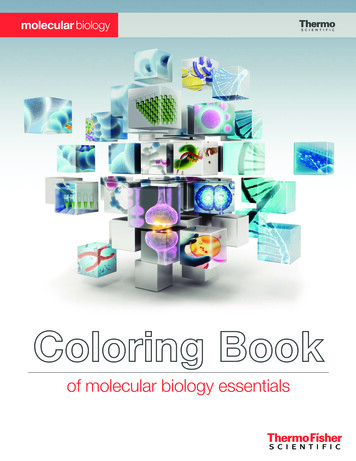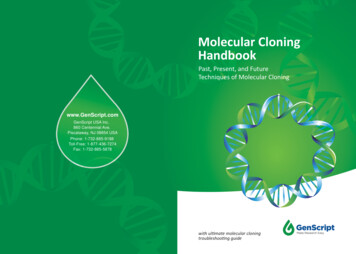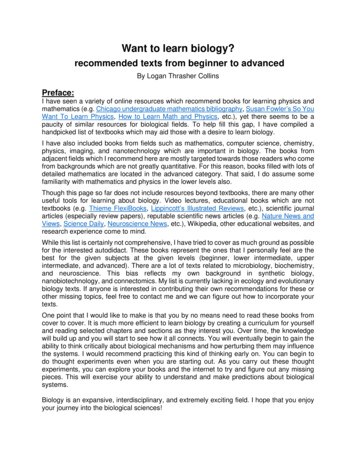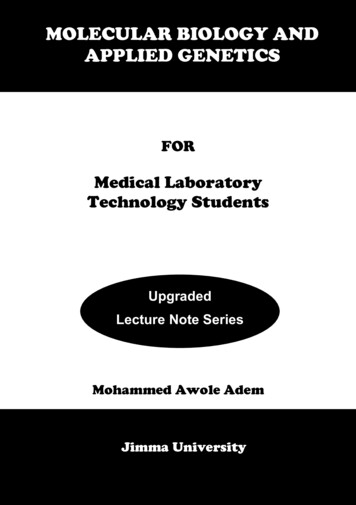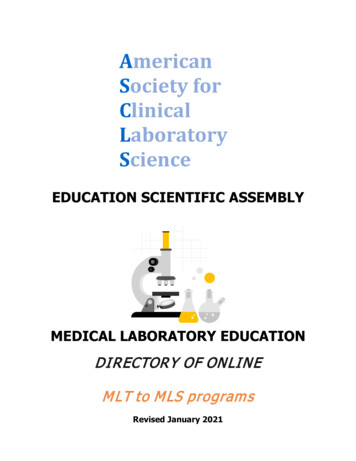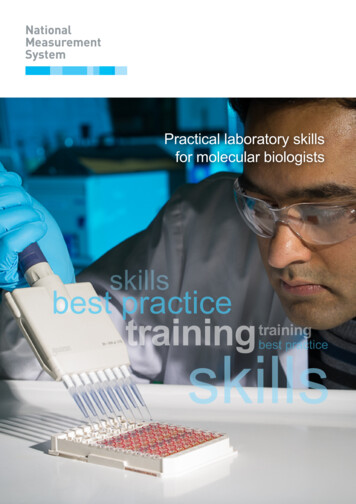
Transcription
Practical laboratory skillsfor molecular biologistsskillsbest practicetrainingtrainingbest practiceskills
Practical laboratory skillsfor molecular biologistsFirst Edition 2016Co-authorsElena SanchezTimothy WilkesContributorsNicholas RedshawAcknowledgementsWith special thanks to Alison Woolford andVicki Barwick for their help in theproduction of this guide.Production of this Guide was funded bythe UK National Measurement System.First edition 2016ISBN: 978-0-948926-28-0Copyright 2016 LGCThis publication should be cited as:E Sanchez, T Wilkes, Practical laboratory skills formolecular biologists, LGC 2016. ISBN: 978-0-948926-28-0
Practical laboratory skills for molecular biologistsOBJECTIVES OF THIS GUIDE31WORKING IN THE LABORATORY41.1Health and Safety issues41.2Laboratory environment101.3Equipment141.4Method selection152MEASURING VOLUME162.1Types of equipment available162.2Markings on equipment used for volumetric measurements222.3Selecting a suitable piece of equipment242.4Cleaning and maintenance of volumetric equipment262.5Checking the accuracy of volumetric equipment272.6Checklists for making measurements of volume283MEASURING MASS333.1Mass versus weight333.2Types of balance available333.3Selecting a suitable balance344QUANTIFICATION OF NUCLEIC ACID MATERIAL414.1Measurement of nucleic acid concentration using UV spectroscopy414.2Fluorescent based systems.434.3Gel electrophoresis455MEASURING PH475.1What is pH?475.2Equipment for measuring pH485.3Care of electrodes525.4Calibration of pH meters535.5Measuring the pH of a liquid555.6Checklist for making pH measurements using a pH meter556PREPARING SOLUTIONS OF KNOWN CONCENTRATION586.1When are solutions of known concentration used?586.2Calculating the concentration of solutions596.3Labelling and storage of solutions666.4Checklist for preparing solutions of known concentration676.5Special considerations when preparing solutions for working with RNA691
7PREPARING REAGENT SOLUTIONS707.1Calculating the concentration of reagent solutions707.2Solution concentrations expressed as %w/v or %v/v707.3Solution concentrations expressed as mol L-1717.4Preparing reagent solutions by dilution717.5Preparing reagent solutions717.6Labelling and storage of reagent solutions717.7Checklist for preparing reagent solutions728PREPARING MASTER MIXES AND SETTING UP MULTIPLE REACTIONS:REAGENT AND SAMPLE TRACKING CONSIDERATIONS738.1Keeping track of reagents when setting up a PCR assay738.2Checklist for preparing the master mix solution748.3Keeping track of samples749CENTRIFUGATION769.1What is centrifugation and when is it used?769.2rpm versus g769.3Different types of centrifuge779.4Correct operation of a centrifuge: safety and quality issues809.5Checklist for using a centrifuge8210QUALITY MANAGEMENT8410.1Definition of quality8410.2Quality management, quality assurance and quality control8410.3International quality standards8510.4Method validation8710.5Sample handling8910.6Archiving9011LABORATORY NOTEBOOKS9111.1Aim9111.2The laboratory notebook9112FURTHER READING9412.1Publications9412.2Websites942
Objectives of this guideWorking in any kind of laboratory will require the analyst to possess a basic set of practical skills.Measuring mass or volume, and preparing solutions of known concentration, are likely to beeveryday activities. In addition, working in a molecular biology laboratory will entail specificconsiderations related to the nature of the materials being handled.Samples analysed in molecular biology laboratories are frequently of biological nature humanor animal tissue which can pose health risks to the analyst. Frequently, the analyte of interest isDNA or RNA which, with current technologies, will need to be amplified in order to be detected.This amplification step is susceptible to cross-contamination from previously amplified material.Therefore, preventing contamination of the samples and protecting the analyst are criticalconcerns for molecular biologists.This guide covers the basic laboratory skills and other measures required to produce valid resultsin a molecular biology laboratory results that are not compromised by poor practical technique,possible cross-contamination or non-validated methodology.This guide is an extension to our “Laboratory skills training handbook”. It is designed to standalone, but where practical exercises could be useful, it is recommended to refer to both incombination.3
1Working in the laboratoryThe laboratory is a potentially hazardous working environment. You may well be usingchemicals, biological materials and equipment which, if not handled correctly, could cause you oryour colleagues harm. However, with the proper procedures in place, work can be carried outsafely. It is essential that you familiarise yourself with the general safety procedures in place inyour laboratory and with any special procedures required to carry out a particular test methodsafely. When working in the laboratory you also need to know how to select an appropriate testmethod and equipment, and understand the importance of following standard operatingprocedures. This section covers: Health and safety issues Selecting a test method and equipment Importance of standard operating procedures1.1Health and Safety issuesWhen working in the laboratory you must always: Wear suitable eye protection (safety glasses or goggles); this is always important but ifusing a UV-transilluminator (to view gels), a full PVC visor should be worn Wear a laboratory coat: the style and colour of the laboratory coat may vary depending onthe specific set-up of the laboratory. ‘Howie’ style laboratory coats with cuffed wrists aregenerally recommended for laboratories where DNA/RNA is analysed using amplificationtechniques to minimise potential carryover of genomic material Wear suitable footwear (e.g. do not wear open-toed shoes or sandals) Wear gloves: gloves are essential in biological laboratories; both to protect the analystfrom hazardous chemicals and biohazards, and to prevent contamination of samples andreagents with biological material from the analyst. There are many types of gloves; a briefsummary of properties and intended uses is included in Table 1-1. It is worth noting thatthe majority of tasks in the majority of laboratories can be carried out wearing naturalrubber or nitrile gloves Wash your hands on leaving the laboratory4
Table 1-1. Considerations when selecting the appropriate type of protective laboratory glovesType of gloveWhen to useWhen not to useNatural rubber (latex)When handling water basedmaterialWhen handling solventsNitrileGeneral use(incidental use)In case of latex allergiesWhen very precise andaccurate handling is requiredas they are relatively thickPolyvinyl chloride (PVC)When handling acids(incidental use)(extended contact)Neoprene(extended contact)ButylAcids, bases, alcohols, fuels,peroxides, hydrocarbons, andphenols(extended contact)Fluoro-elastomer (Viton) (extended contact)When handling organicsolventsPoor for halogenated andaromatic hydrocarbonsKetones and estersGasoline, aliphatic, aromaticand halogenatedhydrocarbonsAromatic and chlorinatedsolventsWater based solutionsChlorinated and aromaticsolventsKetones(extended contact)Polyvinyl alcohol (PVA)In case of allergiesIn the laboratory you should never: Eat or drink Smoke Apply cosmeticsYou should know the meaning of common warning and hazard signs used in the laboratory. Youwill see different coloured signs: Blue signs are mandatory Red signs are prohibitive (or relate to fire alarms/fire-fighting equipment) Green signs give safety instructions Yellow signs give warningsSome examples of signs you may see in the laboratory are shown in Figure 1-1.5
Laboratory coatmust be wornEye protectionmust be wornNow washyour handsNoadmittance tounauthorisedpersonnelNo smokingNo entry forpersons with apacemaker alhazardEmergencyshowerEmergencyeyewashFirst aidToxic materialFigure 1-1. Example of laboratory signs1.1.11.1.1.1Working with hazardous materialsRecognising hazardous substance labellingHazardous substances can take many forms, including: chemicals products/formulations containing hazardous chemicals fumes dusts vapours mists nanoparticles gases and asphyxiating gases biological agents.6ElectricalhazardEmergency exit
The packaging of a substance will display symbols indicating the nature of the hazard. The‘orange square’ symbols, with which you may be familiar, are being replaced. The EuropeanRegulation on classification, labelling and packaging of substances and mixtures (the ‘CLPRegulation’) adopts the United Nations GHS (Globally Harmonized System) hazard pictogramsBoth the old and new symbols are displayed in Table 1-2. With the new system, the hazard is notdescribed with one word, but a statement, which needs to be read carefully.Table 1-2. International hazard symbolsDescriptionOld pictogramNewpictogramHazard typeExploding BombExplosivesFlameFlammable substancesFlame OverCircleOxidising gases, liquids and solidsGas CylinderGases under pressure or compressedCorrosionCorrosive (to metals, skin, eyes)Skull andCrossbonesAcute toxicity (oral, dermal, inhalation)Table continued7
Table 1.2 continuedDescriptionOld pictogramNewpictogramHazard typeExclamationMarkHealth hazard: Acute toxicity (oral,dermal, inhalation)Specific Target Organ Toxicity – SingleexposureHealth HazardSerious health hazard: Mutagenicity,carcinogenicity, toxicity, aspiration hazardEnvironmentHazardous to the aquatic environmentHazard symbol labels are fixed to individual packages of hazardous substances to warn peoplewho handle them or use their contents. Pictograms are also incorporated into supply labels givinginformation about the most significant immediate danger and the emergency action to take. Atypical supply label is shown in Figure 1-2.Figure 1-2. Hazard warning label (old style)8
1.1.1.2Control of substances hazardous to health (COSHH).Employers are required by law to ensure adequate control of exposure of employees in theworkplace to hazardous materials that cause ill health. This includes controlling exposure tomaterials that cause skin diseases and to materials that enter the body through the skin andcause problems elsewhere. The regulations pertaining to this requirement are the Control ofSubstances Hazardous to Health Regulations 2002 (Amended) (COSHH) and employers andemployees are required to comply with its requirements. All parties are therefore required to: assess risks provide adequate control measures and ensure their use and maintenance provide information, instruction and training provide health surveillance in appropriate casesA ‘COSHH assessment’ must be carried out to identify the hazards and risks associated withsubstances used in the laboratory.1.1.1.3Safety data sheetsSuppliers of chemicals must provide an up to date safety data sheet if a substance is dangerousfor supply. Safety data sheets provide information on chemical products that help users of thosechemicals to make a risk assessment. They describe the hazards the chemical presents, andgive information on handling, storage and emergency measures in case of accident. They willalso highlight any specific risks associated with a substance.The information will also help identify what needs to be done to mitigate any hazards to health orthe environment. However, they do not take the place of a COSHH assessment as this has amuch broader content. The material safety data sheet is usually provided online with mostcommercially available products.1.1.2Waste disposalWaste generated in the laboratory needs to be disposed of carefully. Laboratory specificinstructions should be in place for each category of waste and should always be followed. Ingeneral terms, waste generated in a laboratory should be disposed of as follows:1.1.2.1Biohazard wasteThis type of waste includes all utensils, containers, tissue paper, etc. that has been in contactwith biohazardous material. It also includes sample material. This type of waste is usuallysegregated in strong bags (yellow coloured) marked with the biohazard symbol. When these bagsare full they need to be securely closed with strong ties and are usually collected by specialisedwaste companies.1.1.2.2SharpsThis type of waste includes hypodermic syringe needles, scalpel blades and disposable scalpels,glass capillary pipettes, microscope slides and any other equipment used in the laboratorylabelled as sharp. This type of waste is usually collected in yellow bench-top bins labelled withbiohazard warning signs. When the sharps bins are filled to the fill line they must be closed andlocked and collected by specialised waste companies.1.1.2.3Chemical wasteChemical waste (reagents, reaction products, laboratory-prepared solutions, solvents) need to bedisposed of responsibly. Laboratory specific instructions should be in place and followed verycarefully. A common procedure for disposal of solvents and other harmful reagents is to decant9
into ‘Winchester’ bottles within a fume hood. These are labelled with the name of the chemical tobe disposed of. When full, the bottles will be disposed of by specialised companies.1.1.2.4General wasteThis type of waste includes paper, containers, plastic ware and other waste that has not been incontact with chemical or biohazardous material. It can and should be disposed of as normal officewaste.1.2Laboratory environmentLaboratories need to be controlled in a way that is fit for the analytical purpose, does not affectthe quality of the process and maintains sample integrity. In laboratories where PCR (polymerasechain reaction) assays are carried out, contamination prevention measures such as spatialseparation, biocontainment and traffic flow are important considerations that you need to beaware of.1.2.1Spatial separationLaboratories where DNA and RNA material is routinely amplified and analysed should, wherepossible, have distinct separate areas for the different stages of the analytical process. However,although this is one of the most widely cited means of controlling cross-contamination it is, inpractice, the most difficult to set up and adhere to, usually due to space limitations.Typically, in a laboratory performing PCR, pre-PCR sample preparation areas should be separatefrom the PCR set-up areas which, in turn, should be separate from the post-PCR area. A designfor a laboratory that complies with the spatial separation guidelines outlined above is illustrated inFigure 1-3.Figure 1-3. An example of a laboratory layout which demonstrates the spatial separation ofrooms for pre- and post-PCR procedures10
In this type of laboratory, the flow of analysts, samples and reagents should always go in onedirection, from the pre-PCR areas (sample reception, PCR set-up and template addition) to thepositive, post-PCR areas (instrument room). Where analysts need to return to pre-PCR areas,they may be required to wear additional protective clothing such as hairnets and masks toprevent ‘shedding’ post-PCR genomic material. This is a common requirement in forensiclaboratories analysing biological material.Consideration should be given to the concentration of template being handled in the pre-PCRarea. High copy number nucleic acid template could pose a similar cross-contamination risk aspost-PCR material. In cases where the use of high copy number template is unavoidable, it ispreferable that the sample(s) be diluted in a room that is separated from all stages of the PCRprocedure.Where laboratories have the space to separate the different stages of the process, colour codingof all equipment, laboratory coats and, in particular, moveable laboratory ware (such as sampleracks, storage boxes, pipettes, etc.) is highly desirable to stop items moving between areas.Where specific items need to return to pre-PCR areas from post-PCR areas, they must bedecontaminated either by the use of UV radiation, or immersion in ethanol.Laboratory coat colour coding is used to restrict analyst access to the different areas.Figure 1-4. Restricted access entrance to laboratory11
In practice, space constricted laboratories may not have enough room to provide physicalseparation, in which case colour coding of equipment, laboratory ware and even furniture isessential to minimise cross-contamination.You should become aware of the layout of the laboratory and follow very strictly the guidelinesreferring to equipment and analyst flow around the working areas.1.2.2BiocontainmentThe term ‘biocontainment’ is used in relation to laboratory biosafety, and is implemented inlaboratories in which the physical containment of organisms or agents is required. Containment isachieved by isolation in environmentally and biologically secure cabinets or rooms, to preventaccidental contamination of workers or release into the surrounding environment. The level ofcontainment varies from restricted access rooms to the use of biosafety cabinets. The levelrequired depends on the types of samples or reagents used and the sensitivity of the assay to becarried out. It serves both to protect the analyst and environment from a hazard, and to minimisethe contamination of the samples that are being tested.There are three types of biosafety cabinets.1.2.2.1Class I biosafety cabinetOpen-front negative pressure cabinet, with exhaust air from the cabinet filtered by a highefficiency particulate air (HEPA) filter. This cabinet provides personal and environmentalprotection, but not sample protection.Figure 1-5. Diagrammatic representation of a class I biohazard safety cabinet12
1.2.2.2Class II biosafety cabinetOpen-front ventilated cabinet, with vertical laminar flow. These cabinets provide a HEPA-filtered,re-circulated mass airflow within the work space. The exhaust air from the cabinet is also filteredby HEPA filters and therefore it provides personal, environmental and sample protection.Figure 1-6. Diagrammatic representation of a class II biohazard safety cabinet1.2.2.3Class III biosafety cabinetThis is a totally enclosed ventilated cabinet. Operations within the Class III cabinet are conductedthrough attached rubber gloves.Figure 1-7. Diagrammatic representation of a class III biohazard safety cabinetMost laboratories use Class II cabinets as they offer protection against most biohazards whilealso protecting the work in progress.1.2.3A clean and clear benchIn any laboratory, working on clean and uncluttered surfaces is important. In a molecular biologylaboratory there is particular emphasis on working on surfaces that are very clean, with only the13
equipment that is absolutely necessary present. This is to minimise the possibility of crosscontamination from airborne nucleic acid material.After the experimental work is complete, the work surface should be cleared completely; all thelaboratory ware should be cleaned and stored away. The work surface should be wiped with aproprietary solution; in many cases ethanol can be used.Waste such as pipette tips and used Eppendorf tubes should be stored in a container anddisposed of immediately (preferably in a sealed bag) after finishing work.The plastic ware and equipment (racks, pipettes) used in the experiment should be wiped orsoaked with a cleaning solution and, where possible, placed under a UV light.1.3Equipment1.3.1Equipment selectionThe primary requirement when selecting equipment is that it is fit for purpose. The process ofacquiring equipment is usually the responsibility of the laboratory manager. It is quite common tofind that the laboratory offers different models of equipment for seemingly the same purpose andtherefore the analyst will need to ensure that the experimental requirements are served by theequipment specification. For example, the laboratory may have different types of balances, withdifferent precision. The analyst will need to select the type of balance that is best suited to themass and type of sample to be weighed. This will be discussed in more detail in the sections onmeasuring mass, measuring volume and preparing solutions.1.3.2Log books and maintenance recordsAll equipment should have an associated log book that contains at least the following information: Description of the equipment Manufacturer’s serial number Date of receipt and installation Location Software and version installed (if relevant) Records of updates and maintenance checks Faults and resolutions1.3.3Equipment ownershipAll equipment should have an ‘owner’, a nominated member of the team who has responsibilityfor ensuring the equipment is maintained and serviced regularly. The owner should be competentin the operation of the equipment and can be responsible for training other staff. To avoiddamage or incorrect use, it is vital for operators to be fully trained and demonstrate competence,before being authorised to use equipment.1.3.4CalibrationEquipment used to for analytical measurements should be calibrated using measurementstandards and used within the limitations of accuracy and/or capacity specified by themanufacturer. Depending on the complexity of the equipment and the availability of referencematerials and calibration standards, the calibration may be performed in-house or by a visitingengineer. In any case, there should be a calibration schedule for the equipment and recordsshowing checks performed.14
1.4Method selectionRegardless of the management standards adhered to or the type of work being carried out, it isimportant to use methods that are fit for the purpose intended. This applies to all procedures,from those used in the initial sampling, through handling, transport, storage, preparation, analysisand reporting. In ISO/IEC 17025:20051 there is a definite hierarchy of methods that should beused, starting with international standards at the top, followed by published methods (peerreviewed publications) and then laboratory developed methods.When considering the adoption of a new method developed from scratch in-house, a search ofthe relevant scientific literature is the best place to start. The details published in scientific articleswill have been the subject of peer review and can be considered ‘state of the art’. These sourcesof information may assist with gaining further insight into the specifics of a technique. Usefulliterature search engines for this purpose include PubMed at the NCBI(www.ncbi.nlm.nih.gov/entrez), and ScienceDirect (www.sciencedirect.com).Unfortunately in many publications key detail is sometimes missing, making duplication of aprocedure difficult. If this is the case, a more generalised search of the internet may yieldadditional useful information but care should be exercised when selecting appropriate searchterms. Additional sources of useful information include commercial supplier websites, andlaboratory home pages.Many commercial suppliers offer time and effort saving kits that may enable the replication of thedesired technique using validated protocols and reagents. However, these can be expensive andrequire additional equipment supplied by the vendor. An alternative source of information istherefore laboratory home pages. These are frequently established and maintained by leadingresearchers in the field but are not regulated to the same degree as the other sources discussedin this section.Regardless of the source of a method it is essential to ensure that the method has been validatedbefore use (see section 10.4). Even when using published methods that have been previouslyvalidated, checks should be carried out within the laboratory to demonstrate that published levelsof performance can be achieved (and that they are fit for purpose). Without an adequatevalidation exercise there is no guarantee that a method will produce reliable or meaningful data. Itis important to recognise that if a deviation from the original method occurs, then the method willno longer be validated and extra work will be required to establish that the results obtained are fitfor purpose. When performing practical work it is essential to record details of the proceduresperformed and any deviations from the stipulated protocol in a laboratory notebook (see section11.2.3).1.4.1The importance of standard operating proceduresAll test methods should be written up as a clear and unambiguous set of instructions which isoften referred to as a standard operating procedure (SOP). The aim of using SOPs in thelaboratory is to ensure consistent application of test methods. Often analyses will be carried outby a number of different analysts; getting them all to follow the same SOP should improve thecomparability of their results. The publication, storage and circulation of SOPs needs to bemanaged within the laboratory’s quality management system to ensure they are kept up to dateand are easily available.1ISO/IEC 17025:2005 ‘General requirements for the competence of testing and calibration laboratories’15
2Measuring volumeThe majority of work carried out in a molecular biology laboratory involves the precise measuringof small volumes of liquid reagents and enzymatic suspensions. These include preparingsolutions of known concentration (see section 6) and preparing reagents (see section 7).Accurate micro-volumetric measurement, as well as measurement of larger volumes, is thereforea crucial aspect of the work carried out. This section outlines the key points you need toremember to be able to make accurate measurements of volume: The different types of equipment available for handling liquids Which type of equipment to use How to clean the equipment How to check the accuracy of the volume contained in or delivered by different items ofequipment How to use the equipment correctly2.1Types of equipment available2.1.1Automatic pipettesAutomatic pipettes are available in both fixed volume and variable volume models. They aremade out of plastic and metal and the variable volume models are fitted with either a mechanicalor electronic volume setting device.The liquid is confined to a plastic tip, which is readily exchangeable. Automatic pipettes areclassified according to the mechanism they employ for aspirating and dispensing liquids. Twomechanisms are commonly employed and pipettes are therefore classed as being either airdisplacement, or positive displacement.Figure 2-1. (A): Air displacement automatic pipette, (B) Positive displacement automaticpipette. (Image courtesy of Gilson UK)16
2.1.1.1Air displacement pipettesFigure 2-2 shows a schematic of an air displacement automaticpipette. This type of pipette is recommended for use with aqueoussolutions and for routine laboratory work. The piston is part of thepipette and moves a cushion of air between itself and the liquid inorder to aspirate (draw up) and dispense the liquid. The volume ofair displaced is equivalent to the volume of liquid aspirated.Figure 2-2. Diagrammatic representation of an air displacement pipette2.1.1.2Positive displacement pipettesThis type of pipette is usually employed with viscous (thick) andcorrosive (damaging) liquids. With these pipettes, the piston is partof the disposable pipette tip and forms a seal in the pipette tip sothat the liquid is in direct contact with the piston. See Figure 2-3.Figure 2-3. Diagrammatic representation of a positive displacement pipette2.1.1.3Single channel vs. multi-channel pipettesMultichannel pipette models provide higher sample throughputwhen using microwell plates. Adjustable Spacer models, where thespace between the tips can be modified, allow the transfer ofsamples between tubes and different plate formats. Manufacturersgenerally supply multichannel pipettes in 8 or 12 channel formatalthough 16, 48 and 64 channel pipettes are also available for usewith 384 well plates. The volumes that can be dispensed and thetips that are utilised are identical to those employed with singlechannel pipettes. Examples of single and multichannel airdisplacement pipettes are shown in Figure 2-4.Figure 2-4. Examples of single and multichannel air displacement pipettes. (Image courtesy ofGilson UK)17
2.1.1.4Electronic pipettesWith manual pipettes the piston action is accomplished by the usermanually depressing and releasing the plunger with their thumb.With electronic pipettes the piston action is controlled by thepipette. The user pushes a button to initiate aspiration anddispensing of the liquid. Electronic pipettes reduce the forceneeded by the user’s thumb and are of value when repetitivepipetting is required. Electronic pipettes often have multipleoptions, including the mixing and multi-dispensing of liquids.Examples of electronic single and multichannel air displacementpipettes are shown inFigure 2-5.Figure 2-5. Examples of electronic, single and multichannel air displacement pipettes. (Imagecourtesy of Gilson UK)2.1.1.5Pipette componentsThe most common components of a single channel automatic pipette are illustrated in Figure 2-6.Figure 2-6. Automatic pipette components (Image courtesy of Rainin, a Mettler ToledoCompany)2.1.1.6Setting the volumeThe volume of liquid to be aspirated is set using the volumeter. The dials are normally colouredeither black or red to indicate the position of the decimal point, depending on the make and18
model. The volume is set by rotating the thumbwheel or the push-button. Maximum accuracy isobtained by setting the volume as follows:If decreasing the volume setting: Slowly rotate thumb wheel to reach the required setting.Make sure that you do not to overshoot the mark.If increasing the volume setting: Rotate the thumbwheel past the required value byapproximately 1/3 of a turn. Then slowly decrease to reach the volume, making sure not toovershoot the mark.2.1.1.7Basic pipetting technique (forward pipetting technique)When the plunger button is pushed, two stop positions can be felt. The first one is the ‘aspirate’position. The second one is the ‘purge’ position. The basic forward pipetting te
concerns for molecular biologists. This guide covers the basic laboratory skills and other measures required to produce valid results in a molecular biology laboratory results that ar





